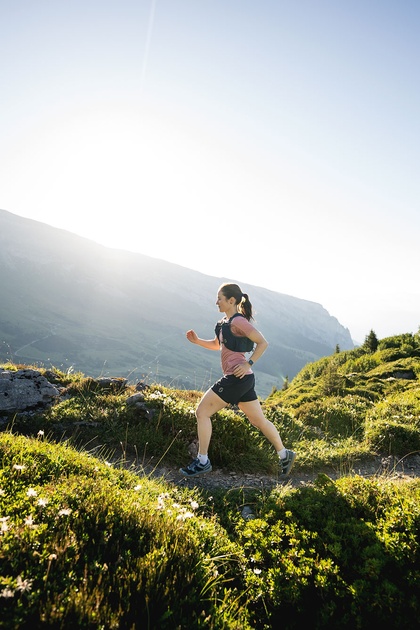
Trail running is flying high
Fotos: ©Egelmair Photography / Zenit
When industry and tourism get behind a sports trend, it is not uncommon for it to become an established sport. That’s exactly what is now happening with trail running.
Trail running is on everyone's lips and hardly a day goes by as a sports editor, without an outdoor company either promoting its new trail running collection or a clothing specialist announcing its entry into the trail running shoe sector. The market is on the trail – and seems limitless.
Almost half of Switzerland goes jogging
In fact, running is generally on a high in Switzerland, as shown by the figures of the GfK survey commissioned by “Swisspo – Fachstelle Sportartikel Schweiz” during the pandemic and published in 2022. The representative survey shows that 48 percent of Swiss people go jogging. Surprising: The proportion of people who go jogging every day has quadrupled in the last three years. However, for many, the focus is not on the performance aspect, but on the idea of health and fitness.
Running is simple, efficient – and good for you. You can run anywhere and at any time, you need hardly any infrastructure and only minimal equipment, small routes and paths can always be found, whether in lowlands or in the mountains. This independence is perfectly accommodated by the trail running segment. Trail running also perfectly embodies the (new) zeitgeist of closeness to nature. No other sport is so close to nature and has such a holistic effect on body and mind.
The "new sport" has also arrived in the media. Newspapers, magazines and online portals are praising all the benefits of trail running in terms of health, and as another potent player, more and more tourist regions are taking a keen interest in the new target group with special tour suggestions and maps.
Justified euphoria
The euphoria is justified. Trail running is an extremely versatile sport, the infrastructure in Switzerland with its dense network of hiking trails is fantastic and already available everywhere, and the potential for conflict with other athletes is minuscule.
At first, however, trail running had to be seemingly forgotten before now being rediscovered. Trail running has been around forever, 10,000 years ago, people ran off-road after their prey for miles as hunters and gatherers. But with the flat surfaces and infinite mobility of modern society, the original running on uneven ground increasingly disappeared. And today we do almost anything in our everyday lives to avoid running, including starting to cover the very last metres to work by e-scooter.
BACK TO THE ROOTS
Trail running stands for the renaissance of original running and is the perfect sport for good health. When running on rough ground and over hill and dale, you have to be able to stabilise your whole body so that you can avoid roots and stones. As a result, more and different muscle groups are used than in normal running. And even the head is trained, so that you can get around on uneven paths with many changes of direction and obstacles without stumbling.
For the trail running boom to really last in the long term, future generations need to rediscover running for what it is: As the most natural and amazingly efficient locomotion under its own power, which strengthens all senses as well as body and mind when performed in a playful way. So, the "Ultra Trail" as a sporting challenge is replaced by the "Pleasure Trail" on the doorstep in everyday life as the ultimate destination. And then it is no longer an extraordinary athletic achievement to be able to run for an hour or two, but basic fitness, which people are basically built and well equipped for.
This must be promoted from an early age and, above all: exemplified. Our wonderful Switzerland is perfect for trail running, and if you try it out and are sufficiently motivated, you will be thrilled. But there are no shortcuts, you have to run yourself, because (fortunately) trail running, as the archetype of human locomotion, is straightforward and transparent – and will continue to be immune to electric tailwinds in the future, unlike cycling.
This may be of interest for you too


